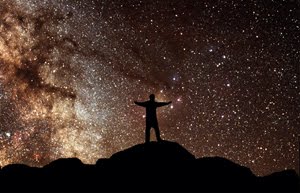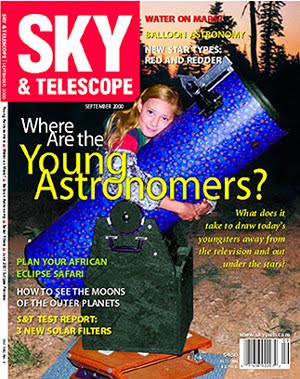The last weekend of February, 1998, I was hoping to get in one night of observing, after what seemed an interminable stretch of cloudy and wet skies. Friday morning, conditions were not looking good, and so, I made other plans for the evening and notified my friends on this mailing list. I took the lack of replies or comments to mean either I don't have any friends, or pretty much everyone agreed that the night did not look good.
Very late afternoon, my prior engagement canceled, and I thought, why not just go and see what turns out. I knew the road to Coe was open, so I headed south. Halfway there, I realized I had not put a message out on the list, and thought, well, it had been a long time since I was able to do any solitary observing, and of course there was the possibility of running into other amateurs at Coe who, like me, thought "why not".
Stopping off for a quick junk food much at East Dunne in Morgan Hill, I thought, hey... I left a message with Ranger Dooley of Pacheco Park, letting him know some of us might be coming down on the weekend. And so, thinking of real solitude, a better road, and the possibility of evaluating that site's main (gravel) lot for future wet weather use, I changed plans and followed 152 to the Dinosaur Point turnoff. The gate was locked, but I have the combination, and after some resistance the combination worked and the gate fell open.
So there I sat, a throw together picnic of brie and baguette, chocolate, Mexican coffee, sunset, crows, cows, coyotes, and a clearing sky. It all felt so good, to be out, to be away.
The lot at Pacheco is not "small" gravel, but it is not large either. The 14.5" dob had no stability problems at all. My feet did not feel individual rocks, so I would not have a problem setting up there in the future.
Now came the observing. I had just finished my dinner and saw the sky open nearly full. It had been so long since I was out like this, just one on one with the sky. The telescope became not a piece of equipment, but an extension of my eye, and the sky, darker than any I remember locally in some time, was my companion for the evening. And she was a *great* looking companion! Funny thing is, as I worked over some of the small open clusters in Canis Major and Puppis, I found myself looking longer and longer, naked eye, at the sky.
It was like being with an old friend, someone lost for years that rekindles some warm familiarity. All my old friends came back to me, just looking, pretty much naked eye. There were some clouds that would drift through, and turn the night into a game of "name that constellation"... kind of a celestial jigsaw puzzle where you could see only some of the pieces and you needed to figure out where they fit.
So, I did that until the effects of the workweek intervened and called me into the truck for sleep.
For the record, Jay Freeman was correct about Pacheco and local fog. Toward the end of the evening, fog became an increasing problem. When I awoke, it was to green hills, draped in fog, with the dawn sun painting the distant clouds in the east from below the horizon. Hot coffee, a stretch of the legs, and I knew that I was rejuvenated. It seemed like ages since I was so satisfied with a night out.
I arrived home, cleaned up and took care of the typical weekend chores. I had had phone calls and e-mails from several friends, some of whom had guessed that I was out observing. We all wondered about observing that night (Saturday), but the sky looked like typical February 1998. The consensus was to not go. Still, there were those little prodding e-mails that just kept arriving, mostly from the contingent in Boulder Creek (Shade and Robinson) who seemed eager to get out. The suggestion was made that we could try the Bonny Doon airport with the Santa Cruz Astronomy Club. I had never been there and decided that it was at least worth a drive up to look at the location, and since my truck was still packed from the night before it was easy to do.
The Bonny Doon airport faces, and this is a guess from memory, mostly north-south along its runway. It is a very nice wide open space with little problem from local light pollution. The dome of Santa Cruz and San Jose are noticeable, although under proper conditions would not pose much of a problem to observers. I think the biggest problem there would be dewing/fog.
Sandra Macika had asked earlier, by e-mail, if I would bring a telescope for her. Since all I had was the 14.5", I decided I would again enjoy the pure relaxation of just eye balling the sky. I have had so many nights of "work" at this hobby, searching for the small and faint, that the "big picture" was again a nice way to pass the evening. So Sandra had a 14.5" scope and 27 Panoptic to play with for the evening. Marsha set up close to Sandra, and the two of them began a pre-Messier Marathon, to warm up for the real event next month. I lent Marsh the 19 Panoptic, to increase the magnification of one particular object, and she immediately fell in love with the "wide-field" look and feel of the design. I played "guide" for the evening, suggesting which Messier to hunt next, offering a bit of help here and there, and confirming hits. If I recall, their list of finds included:
M1, M74 (tough in both scope), M33, M31, M32, M110, M42, M43, M35, M46, M47, M45, M44, M67, M105, M96, M96, M65, M66 and possibly a few I do not recall. Not a bad night for a practice Marathon!
Perhaps Bill Arnett will either post the URL for a suggested Messier Marathon hunting order, or mail a copy to the list, so we can get ready for the real event next month.
The western sky began to fade, as clouds crept higher over the horizon, until all but the easternmost stars burned with their normal intensity. The night was done. People from TAC's mailing list who attended were (aside from me) were Sandra Macika, Jay Freeman, Marsha Robinson, Mike Shade, Jeff Blanchard, John Pierce, some of whom are members of the Santa Cruz club. Several other members of the Santa Cruz club were there as well (other than Chris Angelos, I don't recall names). Thanks to the Santa Cruz club for their hospitality!
For me, It was a great weekend... not perfect observing by any means. Just being out, after what felt like ages, was refreshing. I wondered if I had waited a few hours if the sky would clear again, but after two nights, I was quite satisfied. It was fun to look at the sky again as the "big picture" instead of though the less than one degree view of I had grown accustomed to. I had done something I hadn't done in many, many years, finding it exciting and enjoyable. Getting out for a little piece of the heavens is a good thing.











